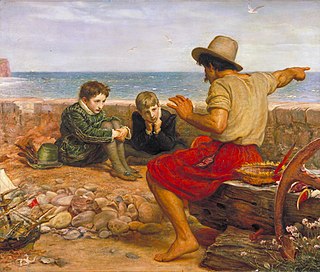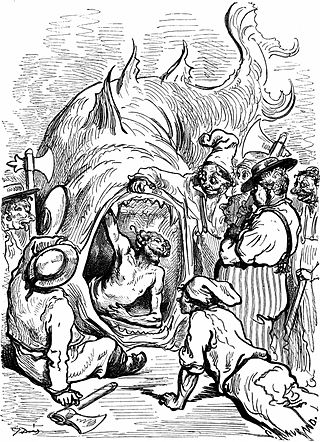
Storytelling is the social and cultural activity of sharing stories, sometimes with improvisation, theatrics or embellishment. Every culture has its own stories or narratives, which are shared as a means of entertainment, education, cultural preservation or instilling moral values. Crucial elements of stories and storytelling include plot, characters and narrative point of view. The term "storytelling" can refer specifically to oral storytelling but also broadly to techniques used in other media to unfold or disclose the narrative of a story.

A story within a story, also referred to as an embedded narrative, is a literary device in which a character within a story becomes the narrator of a second story. Multiple layers of stories within stories are sometimes called nested stories. A play may have a brief play within it, such as in Shakespeare's play Hamlet; a film may show the characters watching a short film; or a novel may contain a short story within the novel. A story within a story can be used in all types of narration including poems, and songs.

A narrative, story, or tale is any account of a series of related events or experiences, whether nonfictional or fictional. Narratives can be presented through a sequence of written or spoken words, through still or moving images, or through any combination of these. The word derives from the Latin verb narrare, which is derived from the adjective gnarus. The formal and literary process of constructing a narrative—narration—is one of the four traditional rhetorical modes of discourse, along with argumentation, description, and exposition. This is a somewhat distinct usage from narration in the narrower sense of a commentary used to convey a story. Many additional narrative techniques, particularly literary ones, are used to build and enhance any given story.
Diegesis is a style of fiction storytelling which presents an interior view of a world in which the narrator presents the actions of the characters to the readers or audience.

An unreliable narrator is a narrator whose credibility is compromised. They can be found in fiction and film, and range from children to mature characters. The term was coined in 1961 by Wayne C. Booth in The Rhetoric of Fiction. While unreliable narrators are almost by definition first-person narrators, arguments have been made for the existence of unreliable second- and third-person narrators, especially within the context of film and television, and sometimes also in literature.
Story structure or narrative structure is the recognizable or comprehensible way in which a narrative's different elements are unified, including in a particularly chosen order and often specifically referring to the ordering of the plot: the narrative series of events. In a play or work of theatre especially, this can be called dramatic structure, which is presented in audiovisual form. The following overviews how story structure works in a cross-cultural and general sense.
Narration is the use of a written or spoken commentary to convey a story to an audience. Narration is conveyed by a narrator: a specific person, or unspecified literary voice, developed by the creator of the story to deliver information to the audience, particularly about the plot: the series of events. Narration is a required element of all written stories, presenting the story in its entirety. It is optional in most other storytelling formats, such as films, plays, television shows and video games, in which the story can be conveyed through other means, like dialogue between characters or visual action.
A frame story is a literary technique that serves as a companion piece to a story within a story, where an introductory or main narrative sets the stage either for a more emphasized second narrative or for a set of shorter stories. The frame story leads readers from a first story into one or more other stories within it. The frame story may also be used to inform readers about aspects of the secondary narrative(s) that may otherwise be hard to understand. This should not be confused with narrative structure. A notable example is The Decameron.
A plot twist is a literary technique that introduces a radical change in the direction or expected outcome of the plot in a work of fiction. When it happens near the end of a story, it is known as a twist ending or surprise ending. It may change the audience's perception of the preceding events, or introduce a new conflict that places it in a different context. A plot twist may be foreshadowed, to prepare the audience to accept it, but it usually comes with some element of surprise. There are various methods used to execute a plot twist, such as withholding information from the audience, or misleading them with ambiguous or false information. Not every plot has a twist, but some have multiple lesser ones, and some are defined by a single major twist.
A flashback is an interjected scene that takes the narrative back in time from the current point in the story. Flashbacks are often used to recount events that happened before the story's primary sequence of events to fill in crucial backstory. In the opposite direction, a flashforward reveals events that will occur in the future. Both flashback and flashforward are used to cohere a story, develop a character, or add structure to the narrative. In literature, internal analepsis is a flashback to an earlier point in the narrative; external analepsis is a flashback to a time before the narrative started.

"A Rose for Emily" is a short story by American author William Faulkner, first published on April 30, 1930, in an issue of The Forum. The story takes place in Faulkner's fictional Jefferson, Mississippi, in the equally fictional county of Yoknapatawpha. It was Faulkner's first short story published in a national magazine.

Narrative criticism focuses on the stories a speaker or a writer tells to understand how they help us make meaning out of our daily human experiences. Narrative theory is a means by which we can comprehend how we impose order on our experiences and actions by giving them a narrative form. According to Walter Fisher, narratives are fundamental to communication and provide structure for human experience and influence people to share common explanations and understandings. Fisher defines narratives as "symbolic actions-words and/or deeds that have sequence and meaning for those who live, create, or interpret them." Study of narrative criticism, therefore, includes form, genre, structure characterization, and communicator's perspective.
Narrative Journalism, also referred to as literary journalism, is defined as creative nonfiction that contains accurate, well-researched information. It is related to immersion journalism, where a writer follows a subject or theme for a long period of time and details an individual's experiences from a deeply personal perspective.
Fiction writing is the composition of non-factual prose texts. Fictional writing often is produced as a story meant to entertain or convey an author's point of view. The result of this may be a short story, novel, novella, screenplay, or drama, which are all types of fictional writing styles. Different types of authors practice fictional writing, including novelists, playwrights, short story writers, radio dramatists and screenwriters.
Show, don't tell is a narrative technique used in various kinds of texts to allow the reader to experience the story through actions, words, subtext, thoughts, senses, and feelings rather than through the author's exposition, summarization, and description. It avoids adjectives describing the author's analysis and instead describes the scene in such a way that readers can draw their own conclusions. The technique applies equally to nonfiction and all forms of fiction, literature including haiku and Imagist poetry in particular, speech, movie making, and playwriting.

The rhetorical modes are a broad traditional classification of the major kinds of formal and academic writing by their rhetorical (persuasive) purpose: narration, description, exposition, and argumentation. First attempted by Samuel P. Newman in A Practical System of Rhetoric in 1827, the modes of discourse have long influenced US writing instruction and particularly the design of mass-market writing assessments, despite critiques of the explanatory power of these classifications for non-school writing.
In literature and other artistic media, a mode is an unspecific critical term usually designating a broad but identifiable kind of literary method, mood, or manner that is not tied exclusively to a particular form or genre. Examples are the satiric mode, the ironic, the comic, the pastoral, and the didactic.
Personal narrative (PN) is a prose narrative relating personal experience usually told in first person; its content is nontraditional. "Personal" refers to a story from one's life or experiences. "Nontraditional" refers to literature that does not fit the typical criteria of a narrative.
In linguistics, psychology, and literary theory, the concepts of deictic field and deictic shift are sometimes deployed in the study of narrative media. These terms provide a theoretical framework for helping literary analysts to conceptualize the ways in which readers redirect their attention away from their immediate surroundings as they become immersed in the reality generated by the text.
The Novel: An Introduction is a general introduction to narratology, written by Christoph Bode, Full Professor and Chair of Modern English Literature in the Department of English and American Studies at Ludwig-Maximilians-Universität München. The first edition of Der Roman was published 2005 at A. Francke Verlag in German; in 2011, the second revised and extended German edition followed, as well as the English translation.





